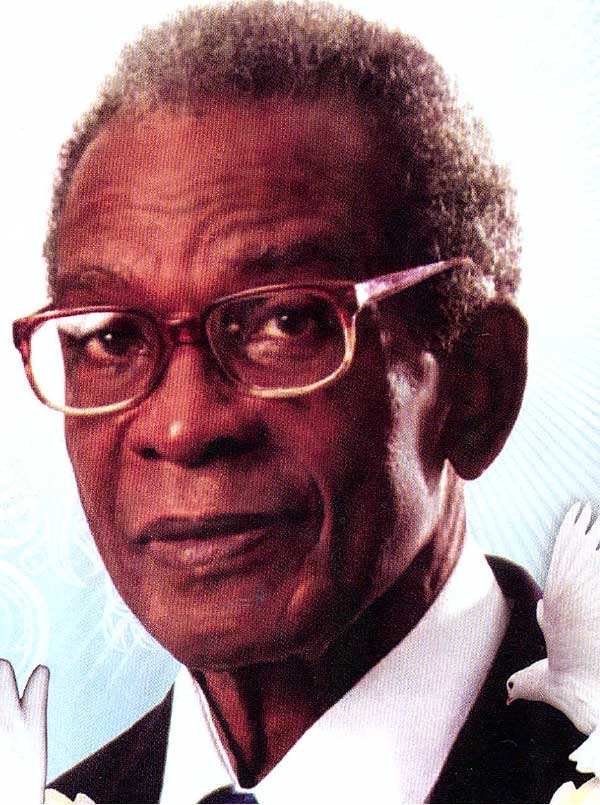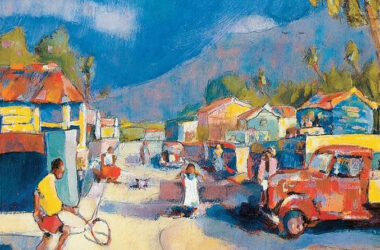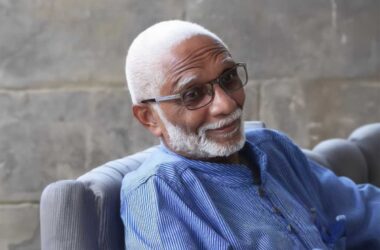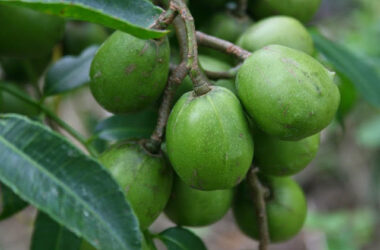An edited version of an Eulogy
By Calixte George
CYRIL Thomas Matthew was born on January 11, 1936 and is a derivative of a well know rural family with extensive roots in the Thomazo/Grande Rivere/Barre de’Lisle and Barre Denis/La Croix Maingot/Vanard/Jacmel/Millet areas of Central Saint Lucia. His father, Stanislaus Matthew was a well respected sugar cane farmer in the Millet/Roseau district and who was strongly and deeply involved in the social upliftment of his area through his active participation as Secretary (or “chief cook and bottle washer” if you prefer) of the then Millet Friendly Society.

In fact, I first met Cyril sometime in 1950 when his father brought the Millet Friendly Society record books to my father Ivan Josephat George, who was an accountant, for auditing according to the laws governing Friendly Societies. Cyril received his early childhood education at the Millet Combined School from 1940 to 1946 and later the St. Aloysius Roman Catholic Boys’ Primary School on Brazil Street.
Attending school in close proximity to the prestigious, premier secondary school institution for boys, St Mary’s College, Cyril was captivated by this renowned institution and aspired to be a student there. With the advent of Presentation Brothers who took over the management of St Mary’s College in 1947, the young, serious, bold and determined Cyril Matthew approached Bro. Macartan Sheehy directly seeking entrance to the awe-inspiring College. Bro. Macartan assigned a young college master, Vincent Floissac (the 1948 Island Scholar who later became a brilliant and eminent and world renowned jurist) to set an entrance examination for Cyril, who passed the examination with flying colours and was admitted entrance into St Mary’s College in 1948, leaving Cyril Matthew no alternative but to find the school fees, which was about sixteen dollars per term at the time. The sole objective then was to make use of this golden opportunity.
He entered St Mary’s College in January, 1948 and exited in December 1955. He made maximum use of his tenure at St Mary’s and participated in all aspects of College life-academics, sports (football cricket, athletics clubs) and organizations. He was an ardent cricketer and made the College’s first eleven team, as an opening fast bowler. He was also a good footballer in mid-field and was a member of the victorious first eleven team that won several football trophies.
He was a member of the Saint Mary’s College Inter-Schools Tournament Team that competed with similar teams from the secondary schools Dominica, St Vincent and the Grenadines and Grenada in 1954. He would later go on to be the winner of both the 100 and 200 races at the College athletics Sports Meet in 1958 and 1959 while playing on the College cricket and football teams during his time at the Imperial College of Tropical Agriculture (ICTA).
His academic pursuits combined classical and academic studies and he was comfortable in both areas. He thus gained the Cambridge Senior Schools Certificate with eight subjects in which he received distinctions in two of them. He caught the attention of Headmaster, Bro. Canice Collins. On passing his Cambridge Senior School Certificate Bro Canice was influential in arranging a fully paid scholarship from the Saint Lucian Agricultural Association to enable him to pursue studies at the Higher School Certificate level. It should be noted that the Saint Lucia Agricultural Association was the first and only corporate citizen to provide scholarships to a secondary school unlike today whereby nearly all corporate business provide scholarships for children of their employees.
Cyril focused his studies in the areas of Chemistry, Biology and Geography in the sixth form. Due to the difficulties experienced by Bro. Canice in recruiting a Science Master with specialisation in Biology, he along with other colleagues like Albert Williams had no alternative but to teach themselves Biology. It was then that he inspired an entire generation of younger students towards the Biological Sciences, with them spying on him while doing his dissections of fishes, Bufo and Rabbits. On account of his determination and tenacity he was successful in Chemistry, Biology and Geography at the Cambridge Higher School Certificate level (equivalent to “A” levels and now CAPE).
On leaving school, he joined the public service as a Technical Assistant in the Ministry of Agriculture where he worked at the Union Agricultural Station under the guidance and Supervision of Mr. Charles Cadet, an Agricultural Science graduate from Mc Gill University, Canada, who was in charge of agricultural research at the time. The nascent banana industry was suffering from an “unknown disease” and Cyril assisted Mr. Cadet in the identification of the cause of the disease – nematodes.
During this period, Cyril continued his sporting activities and was a member of the Catholic Young Men’s Club (CYMC) (now the Catholic Youth Organisation, CYO) and played on their cricket and football teams.
Cyril was awarded the Saint Lucian Government Agricultural Scholarship and proceeded in 1956 to the Imperial Colleage of Agriculture (ICTA) in Trinidad to read for a degree in Agriculture. The Imperial College of Tropane Agriculture (ICTA) was the premier Tropical Agriculture Institution in the British Empire. It was renowned throughout the world for its contribution to tropical agricultural development and thus attracted students from all parts of the temperate and tropical world, and not only the British Empire. The standards in both teaching and research were exceptionally high.
Cyril was therefore tutored by world renowned scientists in Tropical Agricultural specializing in such areas as Tropical Crop Botany, Soil Science, Crop Husbandry (Agronomy), Plant Pathology and Entomology. The rigours of these courses was legendary and Cyril, with strong will and hard work was able to pass through the troughs, tropical storms and hurricanes of ICTA, graduating in 1959 with a diploma in Tropical Agriculture (equivalent of a London degree), and was highly prized and recognized throughout the tropical world.
He returned to St Lucia Ministry of Agriculture and was appointed as an Agricultural Officer and given charge of the Vieux Fort District. However, because of the paucity of trained and qualified officers at the time, he virtually provided technical support services for the Southern half of the island, stretching from both Bath Nursery in Soufriere, across to Micoud in the East and Choiseul and Laborie in between. In that regard, Cyril concentrated on the expansion of the coconut and banana industries in the southern half of the country. In order to achieve his objective, he was responsible for establishing large coconut and banana nurseries at Beausejour Agricultural Station in order to meet the demand of healthy, well selected planting material. He also provided technical assistance in establishing proper drainage systems for the budding banana cultivations of both small and large farmers in southern Saint Lucia. Priority was also given to the introduction of modern technology for vegetable production. In addition, he also paid attention to the rice farmers in selected arears such as Augier, Eau Piquant, La Retraite and Derriere Morne, Black Bay in Vieux Fort, Sapphire in Laborie and AnseGer in Micoud by the provision of improved rice varieties which he obtained from Trinidad.
As the official head of agricultural activities in the south he was headquartered at Beausejour Agricultural Station and was responsible for the management of all lands in the Vieux Fort Area totaling approximately 3,000 acres at the time. He was able to share these lands equitably among both crop and livestock peasants of which there were multitudes in the latter category..
In 1961 Cyril was awarded a British Commonwealth Scholarship to further his studies in the United Kingdom. He entered the University College of Wales in Aberystwyth. In order to improve his knowledge in such a way that he could contribute significantly to the further development of his country, he opted to specialise in the study of Agricultural Economics. Aberystwyth provided an ideal environment for study being far away from the bright lights of London and providing a rural environment somewhat similar to what he was accustomed. He graduated with an Honours degree in Agricultural Economics.
On his return to Saint Lucia, Cyril was seconded from the Ministry of Agriculture to the Saint Lucia Banana Growers Association (SLBGA) to provide technical support for the development of the banana industry which had taken over from sugar as the major agricultural export income earner thus becoming the major contributor to the Gross Domestic Product (GDP) of the country.
Cyril put his whole heart and soul to the development of the banana industry. As the Operations Manager of the SLBGA, he spent long hours both at his desk and in the field. He contributed to all aspects of the banana industry development – mobilization efforts for greater involvement of small peasant farmers in the industry; large estate production, expansion and improvement in production efficiency; identification of research needs; organization of purchasing fruit island-wide; transportation co-ordination of small peasant farmers’ production; establishment of effective seamless payment systems to small farmers as well as support service personnel and contractors; banana reception and part quality control systems; identification and justification for funding the major secondary and tertiary road network system to enable access to and from small peasant farmers holdings, which were more often in the inland and hillside areas of the country.
The banana production system in Saint Lucia and indeed the other Windward Island producing states – Grenada, Dominica and St Vincent and the Grenadines – always faced two major challenges – Leaf Spot Disease Control and Fruit Quality Control. The organization and implementation of Leaf Spot Disease control presented several challenges over the years. Cyril was able to oversee the evolution of leaf Spot Control Systems from the management of ground spraying in individual farmers’ fields with mist blowers to aerial spraying, firstly with helicopters and finally with fixed-winged aircraft, all aimed at increasing efficiency of control while at the same time reducing the cost of control per cultivatable area. His training at Aberystwyth in Agricultural Economics was therefore put to good use.
As Chief Technical Officer and later General Manager of Saint Lucia Banana Growers Association (SLBGA), Cyril established a cadre of technical field officers who provided extension services to small banana farmers and operational services for leaf spot control, reception, selection, processing and boxing of bananas to ensure high quality products.
Significantly the industry was plagued with problem arising from the infection of banana roots with nematodes. This problem was tackled by the Research Division of the Windward Islands Banana Growers Association (WINBAN) for a long time by Dr. Edsel Edmunds who developed various control measures. Cyril was instrumental in ensuring that the control measures and application regimes developed were transmitted to the banana farmers through the establishment of strong links between extension officers and the WINBAN research staff.
After serving the Saint Lucian Banana Growers Association for several years, he was recalled by the government to his original agricultural home, the Ministry of Agriculture to take on the position of Chief Agricultural Officer. During his decade long tenure as Chief Agricultural Officer, he along with myself, his Senior Research Officer, and Laurie Auguste, his Senior Extension Officer, initiated an expanded programme of agricultural diversification which included improvement and expansion of the coconut industry with emphasis on the modernisation of copra kilns; expansion of the cocoa industry with emphasis on processing ; introduction of improved cultures of tree crops particularly citrus, mango and avocado; modernisation of vegetable production systems especially improved cultures of Irish potatoes, tomatoes, cabbage and onions and the introduction and appropriate application of safe agro-chemicals for the control of vegetable diseases and pests. He also focused on the provision of agricultural engineering services especially as they related to land preparation, drainage and irrigation for cooperative groups of farmers such as Black Bay Vegetable Growers.
During this period too, Cyril and I added the new Produce Chemist Laboratory and expanded the research activities at Union Agricultural Station to include Food Technology. The main goal was to give added value to primary agricultural products through agro-processing. Professional scientists were specifically chosen to undergo training in tropical food technology by Professor Sammy at the University of the West Indies, St Augustine, Trinidad.
Among the scientists benefiting from this endeavour were Desmond Destang (now co-owner of Bay Gardens Resort and Hotels), Henry Lubin and Martin Evans. Under the guidance of the Senior Research Officer, these scientists produced a wide array of products such as jams, jellies, juices, nectars and cordials from local fruits such as mangoes, papaya, passion fruits etc. Sadly, local entrepreneurs did not take advantage of the opportunities opened up by the Food Technology Laboratory. Of significance too, was the establishment of the first specialized technical communications unit within any Ministry of the Public Service.
Cyril and I also played a significant and catalytic role in the upgrading of the old Agricultural Cadetship Training Scheme to the Union Agricultural College and linking it with the Morne Technical College (now the Division of Agriculture of the Sir Arthur Lewis Community College) for official certification. This ensured that the Ministry of Agriculture and the agricultural industry generally would always have a cadre of locally trained technical assistants. Cyril contributed directly to the programme despite his heavy workload as Chief Agricultural Officer by lecturing students in Agricultural Economics, Farm Management and Extension Methodology. In order to improve his effectiveness, he underwent a Certificate Course in Farm Management and Extension Methods at the Ruppin Institute in Israel.
Some of the “products” of these training efforts went on to higher studies in various branches of agriculture, to the benefit of the Saint Lucia agricultural sector, as well as regional agricultural institutions. It may also be of interest to note that three of his “pupils,” so to speak, have served as Ministers of Agriculture, Fisheries and Forestry in the persons of Peter Josie, Ezekiel Joseph and myself.
As Chief Agricultural Officer, Cyril was also responsible for Fisheries and Forestry. He was able to convince the Minister at the time, Ira d’Auvergne, of the need to pay more attention to Fisheries and Forestry. Additional staffing and physical and financial resources were provided to these embryonic divisions and later they were elevated to full fledged Departments of Fisheries and Forestry.
As Chief Agricultural Officer, Cyril was an extremely hardworking, dedicated, thorough, precise, faithful public officer and was a model of the perfect Civil Servant. Because of his outstanding performance and trustworthiness as Chief Agricultural Officer, on the promotion of Dr. Greaham Louisy to the position of Cabinet Secretary, he was appointed to the position of Permanent Secretary in the Ministry of Agriculture in 1979. He served for a decade with his customary zeal and thorough dedication to the upliftment of the agricultural sector.
Cyril served as the Saint Lucia Government representative at several agricultural fora, both regionally and internationally. He was a board member of the Caribbean Agricultural Research and Development Institute (CARDI). He represented Saint Lucia at numerous CARICOM Agriculture and UN Food and Agriculture (FAO) trade meetings. He also served as a representative to the European Development Fund conference on the Lomé Convention in Togo where he was most comfortable because the Togonians spoke French Creole similar to what he knew in Saint Lucia.
During this period, he served as a Director of several important developmental institutions: the Saint Lucia Banana Growers Association, Saint Lucia Marketing Board, Agricultural and Industrial Development Bank, Central Water Authority (now WASCO), National Development Corporation (now Invest Saint Lucia), Saint Lucia Fish Marketing Corporation, Saint Lucia Model Farms Company, Government Funding Scheme and the Government Training Committee.
Since he was held in high esteem, not only by his colleagues at the Ministry of Agriculture but also by several other ministries and Statutory Boards throughout the Public Service he was elected to the coveted position of President of the Civil Service Association. During this tenure he served diligently to improve the salaries and working conditions of public officers. The long dream of the CSA having its own home came to fruition with Cyril negotiating for the financing of the construction of the Headquarters Building at Sans Soucis. In this, the association was assisted by the Prime Minister John Compton who generously donated a reasonably sized lot from the Sans Soucis Housing Development Scheme at a token or peppercorn price. This enabled the association under the indefatigable efforts of Cyril Matthew to establish and manage a Cooperative Supermarket to cushion the high prices of food resulting from the escalating fuel prices in the early to mid-1970s. For the first time in its history, the Civil Service Association was able to provide group life and health insurance facilities for its members through negotiations with Colonial Life Insurance Company (CLICO) of Trinidad and Tobago.
The entry of the United Kingdom into the European Union was the first indication of changes in the Banana marketing arrangements of the Windward Islands in the United Kingdom market. The beginning of the end of the GREEN GOLD era was in the air. The problems arising therefrom in the production, organisation of joint marketing and research; and the farmer and industry responses to the crisis probably led to the untimely death of Daniel “Chong” Perryman, the hardworking dedicated pioneer Managing Director of the Windward Islands Banana Growers Association (WINBAN). All key stakeholders of the different Banana Associations in Saint Lucia, Dominica, St Vincent and the Grenadines and Grenada as well as their respective governments unanimously called upon Cyril Thomas Matthew to fill the vacuum created by the Perryman’s terrestrial demise.
Cyril Matthew was seconded from the Saint Lucia Government Service to assume the position of Managing Director of the Windward Islands Banana Growers Association (WINBAN). This could be considered to be the “high water mark” of his career. Cyril, in his usual calm systematic approach to problem solving, rose to the challenges faced and served WINBAN diligently from 1983 to 1993. He was directly responsible for the management of a suite of common services for the Windward Islands Banana Industry including: the Banana Insurance Scheme; packaging and marketing of Windward Islands bananas in the UK and Europe; procurement of appropriate industry imports, particularly agro-chemicals such as fertilizers and pesticides. Most importantly, he served as the negotiator of the contracts between Geest Industries and the Windward Islands Banana Growers Association. During this period, his greatest challenge was the banana fruit quality problems, which arose constantly because of the dynamic new stiff marketing competition faced with Latin American fruit on the European Market.
He served as a director of the Windward Islands Packaging Company (WINERA) and the Banana (Protection and Quality Control) Committee. At the Caribbean level, he served as the Secretary and Coordinator of activities of the Caribbean Banana Exporters Association (CBEA).
During the troubling period of the banana strikes in the 1990s, Cyril was called back by Prime Minister John Compton to chair the Board of Directors of the SLBGA, which was in turmoil. He assisted in negotiations with Geest Industries that eventually led to entirely new marketing arrangements for Windward Islands bananas in the United Kingdom. Cyril, therefore, played a key role in the initiation and establishment of the Windward Islands Exporting and Development Company (WIBDECO) and became one of the first Directors.
The versatility and multi-talented nature of Cyril has been expressed not only in his mechanical engineering skills in the design of Banana Boxing plants, in which he was assisted by his brother Evans, but also in the fact that during all these years of intense hard work and dedication at his various high demanding jobs, he was able to study and successfully pass examinations in Accountancy and Business Management. He was a fully qualified Certified Management Accountant from the Society of Management Accountants, Ontario, Canada. He was a fellow of Business Administration (FBA) of the Canadian School of Management and Master of Business Management (MBA) of the Northland Open University of Canada. He was also a Member of the Institute of Chartered Accountants of Saint Lucia.
The knowledge gained from his Management Accounting and Business Management studies combined with his vast experiences in managing several important state and statutory institutions was to the advantage of the Saint Lucian Civil Service Cooperative Credit Union. In fact, his thesis for the fulfillment of his Master of Business Administration (MBA) was on the “Evaluation of Cooperatives Performance in Saint Lucia”.
After his retirement from the Public Service, Cyril was offered the position of General Manager of the Saint Lucia Civil Service Cooperative Credit Union where he served for a decade and a half. During his tenure there the institution rose to become one of the most successful Credit Unions in the country, providing loans of varying kinds to its members especially for housing. The assets rose significantly including the possession of its Headquarters Building at the corner of Jeremie St. and Chaussée Rd.
As the country began to modernise its institutions in order to become more competitive in this new globalisation era, the issue of establishing proper international standards in agriculture, manufacturing, industry, agro-processing, trade, and health became paramount. In that regard, the government called upon Cyril to provide guidance and advice on the establishment of a Bureau of Standards. Thus, Cyril was appointed the first Chairman of the Bureau of Standards where he developed initial procedures and systems and recruited and trained appropriate staff in the several scientific disciplines required for an effective functional establishment.
He served as a Director, Chairman and First Vice President of the Board of Directors of the Saint Lucia Cooperative Bank, now 1st. National Bank Saint Lucia Ltd. He also served as a Commissioner of the Income Tax Appeal Commission and on the Public Service Board of Appeal. He was a long standing member of the Rotary Club of Saint Lucia.
Cyril Matthew was honoured by Her Majesty the Queen as a member of the Most Excellent Order of the British Empire (O.B.E.) and the Saint Lucia Government bestowed him with the Saint Lucia Medal of Honour (Silver).
I knew Cyril Matthew for 66 years and I consider him to be one of the humblest and greatest Saint Lucians of my generation.






Dear Madam, Sir:
I found your detailed and professional eulogy incidentally, looking for my good old friend Cyril T Matthew. From your report I was impressed to learn about Cyril´s successful national and international career and how prominent Cyril had become and how valuable his work was for his country.
I first met Cyril in London together with other students from the West Indies in 1963 during the Cuba crisis and when Marilyn Monroe passed away. We shared a room in Catholic International Student´s Hostel for a couple of months. Cyril studied in Aberystwyth /Wales/UK at that time. I was a student as well, studying Economics at Cologne University/Germany, working as a computer programmer for IBM UK during my university vacation in order to earn some pocket money. We undertook a lot of trips together and always had great fun with each other.
When we returned to our studies, we kept in touch for many years, especially during Cyril´s time with SLBGA, but unfortunately lost contact to Cyril at least 10 years ago or more. Last time, when I had contact with Cyril he told me that he has eight children.
I would be very grateful, if you could help me to re-establish my contact to Cyril. Thank you very much indeed. Please do not hesitate to contact me, should you need further infotmation
Sincerely,
Carlo Padilla
Postal address: Gartenstrasse 21, D – 47661 Issum/Germany, phone +49 2835 92686
Thank you for your lovely note about my father. I’m his first daughter and he was my world. We were extremely close and he has always been the most honorable, principled, and humble man and father I’ve ever known. I will be in touch with you. Gwyneth.